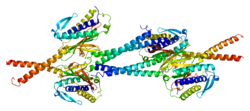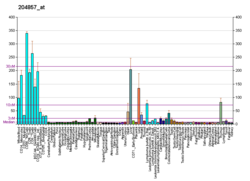Top Qs
Timeline
Chat
Perspective
MAD1L1
Protein-coding gene in the species Homo sapiens From Wikipedia, the free encyclopedia
Remove ads
Mitotic spindle assembly checkpoint protein MAD1 is a protein that in humans is encoded by the MAD1L1 gene.[5][6][7]
MAD1L1 is also known as Human Accelerated Region 3. It may have played a key role in the evolution of humans from apes.[8]
Remove ads
Function
MAD1L1 is a component of the mitotic spindle-assembly checkpoint that prevents the onset of anaphase until all chromosome are properly aligned at the metaphase plate. MAD1L1 functions as a homodimer and interacts with MAD2L1. MAD1L1 may play a role in cell cycle control and tumor suppression. Some studies indicate associations of MAD1L1 with psychiatric disorders, including schizophrenia, bipolar disorder, and depression. [9][10][11] Three transcript variants encoding the same protein have been found for this gene.[7]
Remove ads
Interactions
MAD1L1 has been shown to interact with:
See also
References
Wikiwand - on
Seamless Wikipedia browsing. On steroids.
Remove ads






